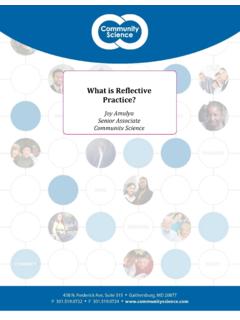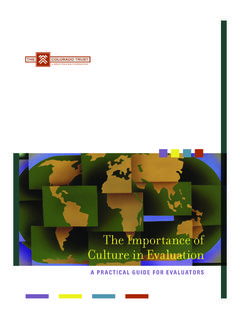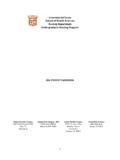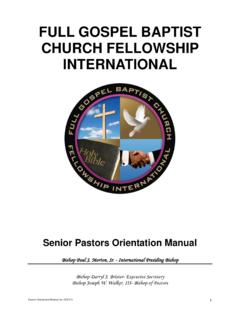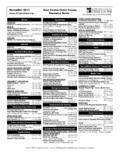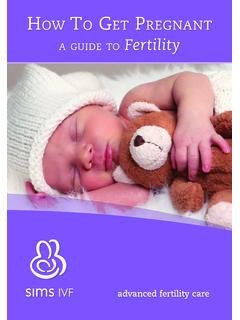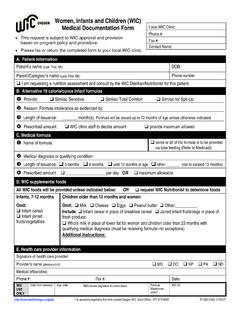Transcription of Participatory Asset Mapping Toolkit - Community Science
1 ParticipatoryAsset MappingCOMMUNITY RESEARCH Community RESEARCH LABTOOLBOXCOMMUNITY RESEARCH LABTOOLBOXATOOLKITAPril 2012a program of1 Participatory Asset Mapping AcknowledgmentsAcknowledgmentsThis Toolkit was made possible through our work with Advancement Project s Urban Peace Institute and such organizations as the Alliance for a Better Community (ABC) and Community Coalition. Healthy City, through the Community Research Lab, developed this Toolkit with funding from First 5 Los Angeles. This and other toolkits can be accessed through the Healthy City website at : Janice C. Burns, ; Dagmar Pudrzynska Paul; and Silvia R. Paz, : Taisha Bonilla, ; Deanna Cooke, ; and Tahirah Farris, AICP, Woo and Colleen Corcoran / more information, visit or contact us at (213) 989-1300.
2 Copyright Dec. 2011 Advancement Project Healthy CityUpdated April 2012 All rights reserved. Use and reproduction of these mate-rials in any format should be credited to Advancement Project- Healthy City Community Research Lab. Materials are not to be used or sold for commercial purposes or UsAdvAncement ProjectAdvancement Project ( ) is a public policy change organization rooted in the civil rights movement. We engi neer large-scale systems change to remedy inequality, expand opportunity and open paths to upward mobil ity. Our goal is that members of all communities have the safety, opportunity and health they need to thrive. Advancement Project s Programs include: Educational Equity, Equity in Public Funds, Healthy City, and Urban Peace Institute.
3 HeAltHy cityHealthy City ( ) is an information + action resource that unites Community voices, rigor-ous research and innovative technologies to solve the root causes of social inequity. We transform how people access and use information about their communities. As a program of Healthy City, the Community Research Lab partners with Community -based organizations to develop, implement, and disseminate data/ Mapping projects, tools, and workshops that promote Community knowledge and Community Based Participatory Action Research. 2 Participatory Asset Mapping How cAn tHis Toolkit be UsefUl in yoUr sPecific work or Projects?About this toolkitHow can this Toolkit be used? +As an instructional Toolkit for using and applying Participatory Asset Mapping .
4 Community -Based Organizations can use the concepts, methods, and tools provided, such as the Community -Engaged Mapping Facilitation Guide and Guide to Planning a Community -Engaged Mapping Event, to host an event or activity that collects knowledge and experiences from Community members about local assets. +As a workbook for workshops on using Participatory Asset Mapping as a tool for identifying Community strengths and supporting change initiatives. It can be used to help plan and facilitate a workshop on how to implement an Asset Mapping event in your organization or Community . +As a resource and information guide for conducting research within the CBPAR will you find in this Toolkit ? +key research concepts and methods +Additional tools you can Use, with in-depth guides for applying the concepts and methods +glossary terms in bold +notes like the one below to write down any thoughts or ideas you have as you readAbout the toolboxHealthy City supports communities in identifying, organiz-ing, and sharing its collective voice with decision makers at the local and state levels.
5 Through the Community Research Lab, we share best practices and methods for Community -Based Organizations (CBOs) interested in supporting their strategies with research that combines Community knowledge with Healthy City technology. Toward this aim, we have developed the Community Research Lab Toolbox. The toolbox presents research concepts, methods, and tools through topical guides and toolkits such as Community Research, Participatory Asset Mapping , and a Short Guide to CBPAR (all of which can be accessed at ). It is based on best practices from our work with CBOs and a unique approach to the Community Based Participatory Action Research (CBPAR) framework, which promotes research that: 1. Starts with issues and strategies then produces analysis that informs action2.
6 Uses Mapping technology to engage organizations in the research process3. Is both Community -based and place-based, often focusing on a geographic place such as a neighborhoodThe toolbox s CBPAR framework explicitly focuses on Community -based organizations that bring together com-munity members to visualize and actualize research and its outcomes. This includes non-profit organizations that operate in specific, local communities and are staffed by, work with, represent, assist, and/or advocate on behalf of residents of those communities on issues that affect their quality of life. These organizations have worked to gain trust among Community members and have brought together a spectrum of people with varying ideas and perspectives that unite around a particular set of concerns relevant to a large portion of the Community .
7 Though it may have utility for other groups, it supports these organizations whose work directly engages Community members in creating change. 3 Participatory Asset Mapping This page left intentionally Asset Mapping I. wHAt is Participatory Asset Mapping ? 6II. wHy sHoUld yoU do it? 7 III. wHen sHoUld yoU do it? 8 -Using Asset Maps in Advocacy and Policy 8 -Using Asset Maps in Community Outreach 8 -Using Asset Maps in Community Organizing 9I V. How do yoU do it? 10 Methods 10 - Community -Engaged Mapping 10 -Social Investigation 11 Interviews Surveys Community WalksTools 12 -Online Mapping 12contents5 Participatory Asset Mapping contentsV.
8 WHAt do yoU do witH yoUr resUlts? 13 -Analysis 13 -Reports 14 -Presentations 14 -Databases 14VI. conclUsion: Community knowledge on tHe mAP 14 VII. glossAry 15 VIII. AdditionAl tools yoU cAn Use 18 -Appendix A: Case Study: Using Participatory Asset Mapping for Advocacy and Policy in Boyle Heights and East Los Angeles (Alliance for a Better Community ) 19 -Appendix b: WikiMaps User Guide (formerly Live Mapping ) 20 -Appendix c: Community -Engaged Mapping : Planning an Asset Mapping Event 23 -Appendix d: Community -Engaged Mapping : Asset Mapping Facilitation Guide 26 -Appendix e: Ethics in Community Based Participatory Action Research 40IX.
9 References 416 Participatory Asset Mapping Imagine moving into a new neighborhood. As a new resident of this neighborhood, you may want to know the location of the closest major grocery store or the largest library, the best local restaurant or elementary school. You may have many options for finding this information but your best option would be to ask someone who lives there. Your new neighbors could direct you to the location of the grocery store or elementary school, as well as offer a wealth of information, contacts, and personal experiences about them. Now, imagine working with a group of your neighbors to identify the locations of these local resources and places on a map, with information and personal experiences about each.
10 This would be the beginnings of your own Participatory Asset Mapping activity. Participatory Asset Mapping combines the concepts of Participatory Mapping and Asset Mapping . Participatory Mapping is the process of creating a tangible display of the people, places, and experiences that make up a Community , through com-munity members themselves identifying them on a map. Asset Mapping is the general process of identifying and providing information about a Community s assets, or the status, condition, behavior, knowledge, or skills that a person, group, or entity possesses, which serves as a support, resource, or source of strength to one s self and others in the Community . Together, these two concepts inform Participatory Asset Mapping , a process where Community members collectively create Asset maps by identifying and providing the information about their own Community s assets on a map.
